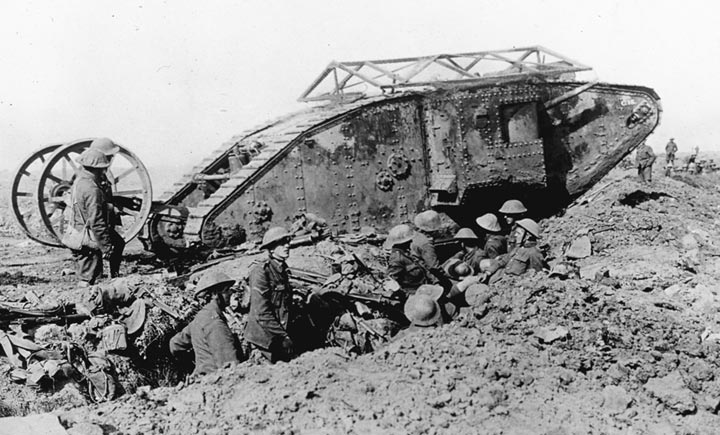MB367/148991, Victoria League of New Zealand Records, Five Royal Artillerymen and a New Zealand trooper behind a wall of 18-pounder shells near Becourt Wood (Lt. Ernest Brooks; Becourt Wood, France; September 1916).

Royal Artillerymen

MB367/148991, Victoria League of New Zealand Records, Five Royal Artillerymen and a New Zealand trooper behind a wall of 18-pounder shells near Becourt Wood (Lt. Ernest Brooks; Becourt Wood, France; September 1916).
As battle itself was difficult to depict, British propagandists utilised other symbols to inspire and inform the home front during the war.
This photograph, by British official photographer Lt. Ernest Brooks, depicts a British Mark I Tank moving across a trench during the Battle of Thiepval, 1916. This image reflects the importance of depictions of munitions as propaganda during the war. This photograph would have been a novelty to a contemporary audience, as it depicts one of the first uses of tank technology in battle. The debut of the tank occurred earlier in September 1916, during the Battle of Flers-Courcelette, as a way to break the deadlock of the Somme. The British were the first to develop and use the tank, and its introduction stood as further proof of the changes to traditional warfare during the First World War. This was something that was important to depict to the British public. By September the public were becoming aware that the Battle of the Somme would not provide the breakthrough that had been promised, so propagandists looked for new ways to display British progress. Images of munitions were an established way to reassure the war-weary public that progress was being made, and victory assured. In depicting the tank, propagandists promoted the message that victory was certain due to the British and Allied armies being apparently the most technologically advanced in the war. In reality, the use of tanks did not significantly mitigate the devastation and loss of the Somme. Despite the novelty and reassuring message of this image, this photograph also reflects the limitations of early tank technology. The first tanks to be used were actually rather unreliable, and often broke down. Of the 49 tanks intended for the Battle of Flers-Courcelette, only 21 eventually made it into action. In this case, the tank has become grounded in the uneven landscape of the Western Front, and stuck while trying to cross a trench.